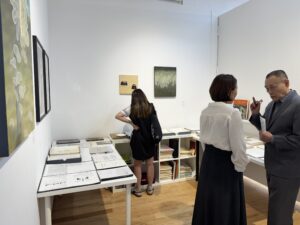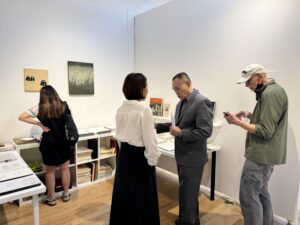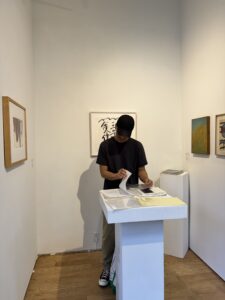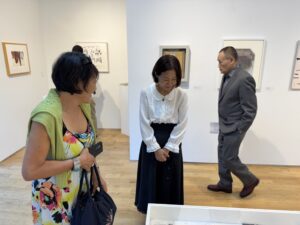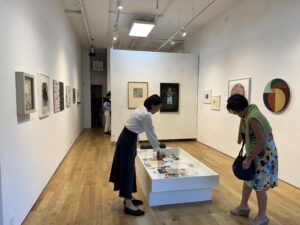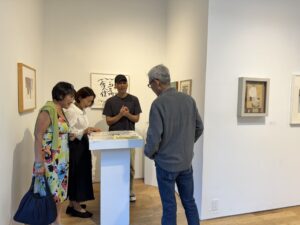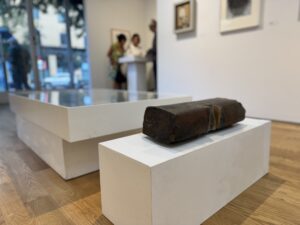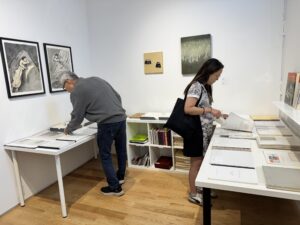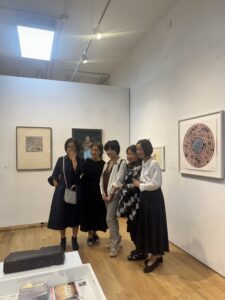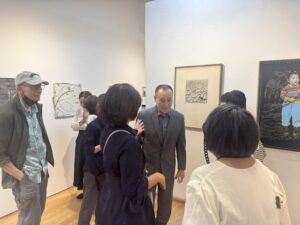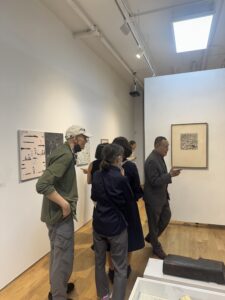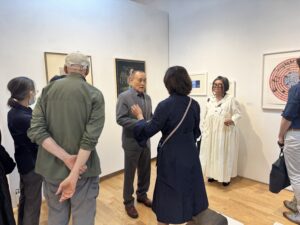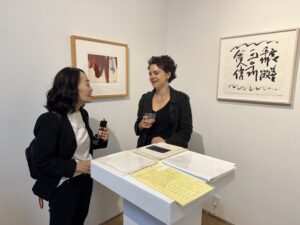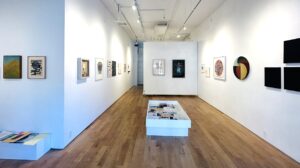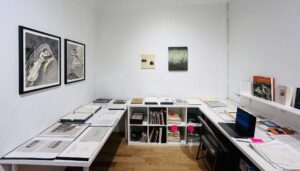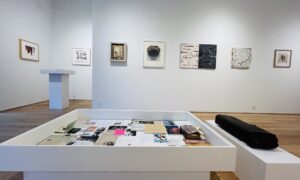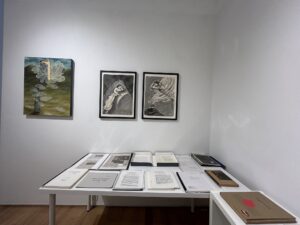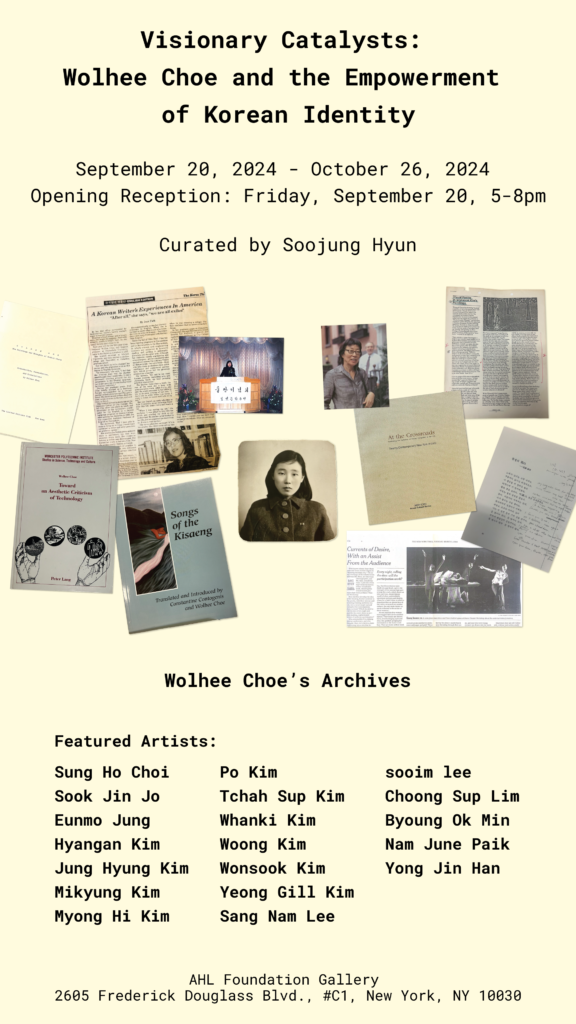
Visionary Catalysts: Wolhee Choe and the Empowerment of Korean Identity
- September 20, 2024 – October 26, 2024
- Opening Reception: Friday, Sep. 20. 5-8pm
- AHL Foundation Gallery
- 2605 Frederick Douglass Blvd., #C1, New York, NY 10030
- Curator: Soojung Hyun
The AHL Foundation is pleased to announce the upcoming archival exhibition, Visionary Catalysts: Wolhee Choe and the Empowerment of Korean Identity, which will be on view from September 20 to October 26, 2024, at the AHL Foundation Gallery in New York City. Curated by Soojung Hyun, this exhibition explores the evolving cultural identity and artistic accomplishments of Korean-American artists during the transformative decades of the 1990s and 2000s. It offers a unique opportunity to view rare archival materials and artworks that have significantly influenced the Korean-American art scene, contextualized within the broader movements of globalization, multiculturalism, and postmodernism.
The exhibition focuses on the archive of Wolhee Choe (1937.8.20 – 2013.5.27), a pioneering figure in the fields of English literature, translation, and cultural advocacy. Choe’s truthful contributions to Korean art and culture in the United States were instrumental in fostering a deeper understanding of Korean identity among diverse audiences. Her archives, which were generously donated to the Archive of Korean Artists in America (AKAA) by her husband, Robert Everett Hawks (1943- 2020), in 2014, include a remarkable collection of personal records, photographs, letters, writings, her doctoral dissertation, and manuscripts for her publications. This collection highlights Choe’s extensive cultural role and her interactions with artists and intellectuals of the time, as well as her influence in empowering Korean-American artists and communities.
Wolhee Choe’s archival materials provide a window into the cultural dynamics of the period, demonstrating her visionary efforts in bridging the gap between traditional Korean culture and the contemporary art world. The exhibition highlights the impact of intellectually advanced individuals in history, showcasing many artists who pursued personal achievement in the New York art world. Beyond commemorating the legacy of one individual, it seeks to inspire future generations and encourage ongoing dialogue, artistic growth, and cultural exchange within the Korean diaspora.
Exhibition Highlights Include:
- Wolhee Choe’s Archives: A comprehensive collection of her personal documents, letters, essays, autobiographical writings, translations, and book publishing. Especially, communication archives, press reviews, books for a collection of poems written by the Kisaeng of the Joseon Dynasty which showcased her scholarly and cultural contributions.
- Featured Artists: Sung Ho Choi, Sook Jin Jo, Eunmo Jung, Hyangan Kim, Jung Hyung Kim, Mikyung Kim, Myong Hi Kim, Po Kim, Tchah Sup Kim, Whanki Kim, Woong Kim, Wonsook Kim, Yeong Gill Kim, Sang Nam Lee, sooim lee, Choong Sup Lim, Byoung Ok Min, Nam June Paik, Yong Jin Han.
Curatorial Essay by Soojung Hyun
Encountering the World Opened by Touch: Memories in the Archive
In a world increasingly dominated by digital and virtual experiences, the tangible nature of physical archives maintains a unique and irreplaceable significance. Archives are not just static repositories where history is stored; they are living collections that preserve memory, identity, and culture. For marginalized communities, such as Korean-American artists, these archives are crucial in ensuring that their voices, stories, and contributions are not lost but rather preserved for future generations to engage with and learn from.
Established in 2013, the Archive of Korean Artists in America (AKAA) functions as a vital reservoir of memories. Its primary mission is to safeguard the materials and experiences of Korean-American artists, providing a comprehensive understanding of their artistic journeys while situating their work within the broader narrative of art history. The archive comprises individual contributions from artists who have generously donated a range of physical materials, including catalogs, letters, photographs, personal papers, and artworks. In addition, the AHL Foundation, which houses the AKAA, continues to curate and publish intangible materials, such as video and audio recordings, ensuring that the full spectrum of the Korean-American artistic experience is documented and preserved. These archives are not mere collections of objects; they play a pivotal role in shaping the history of Korean-American art, offering a space where the legacies of artists can be explored, understood, and appreciated across time.
Among the invaluable personal donations within the AKAA is the collection belonging to Wolhee Choe (1937–2013), a pioneering figure in English literature, translation, and cultural advocacy. Choe’s truthful contributions to Korean art and culture in the United States were instrumental in cultivating a deeper understanding of Korean identity among diverse audiences. Her archives, generously donated to the AKAA by her husband, Robert E. Hawks (1943- 2020), in 2014, encompass a remarkable collection of personal records, photographs, letters, writings, her doctoral dissertation, and manuscripts for her publications. The archive research reveals Choe’s extensive cultural influence, her interactions with artists and intellectuals of her time, and her efforts to empower Korean-American artists and communities.
While the exhibition’s highlight is primarily based on Wolhee Choe’s archival materials, it transcends the study of a singular individual. It seeks to comprehend the broader contexts and dynamics of the era in which she lived through her activities and engagements. By examining Choe’s archive, we can map human relationships and networks within the Korean-American artist community, emphasizing how these connections played a role in shaping both individual and collective artistic identities. The period of the 1990s and 2000s is framed as transformative, marked by increased globalism and multiculturalism, which allowed Korean-American artists to assert their cultural identities while gaining international recognition, particularly in New York’s diverse art scene. This context further underscores the importance of Choe’s contributions, not just as an individual but as a catalyst for a broader movement of cultural exchange and artistic evolution. Additionally, the archival research can provide a further understanding of the connections within the Asian-American artist community.
The archival exhibition Visionary Catalysts: Wolhee Choe and the Empowerment of Korean Identity showcases Korean artists’ empowerment in New York alongside the Wolhee Choe Archive. The exhibition showcases nineteen artists, including Nam June Paik, Whanki Kim, and Po Kim who were settled in New York around the 1960s. While honoring the intellectual legacies of pioneers, this exhibition also showcases the works of the following artists who strove for personal accomplishment. Wolhee Choe wrote the catalog essay “Punctuating Paradox” for At the Crossroads, the 100th-anniversary exhibition of Korean immigration at the Korean Cultural Center in 2003. Most featured artists in Visionary Catalysts were also part of this milestone exhibition. By delving into Choe’s cultural role and influence, the exhibition reflects on the impact of intellectually engaged individuals in shaping and empowering Korean-American artists within the broader context of postmodernism and multiculturalism.
The title of this essay, Encountering the World Opened by Touch: Memory in the Archive, implies a poetic and reflective intention that aligns with the purpose of the exhibition. It resonates with the core themes of memory, archiving, and cultural identity showcased in Visionary Catalysts: Wolhee Choe and the Empowerment of Korean Identity. This exhibition’s archival materials and artworks offer a tactile and sensory experience that bridges the past and present, inviting viewers to engage deeply with the life and legacy of Choe and the broader narrative of the Korean-American experience.
The notion of Touch underscores the distinctive sensory engagement that archives provide. Unlike the digital realm, where information is intangible and ephemeral, physical archives enable us to encounter history in a tangible manner. The act of touching letters, photographs, and documents fosters an intimate connection with the individuals and objects that have shaped our collective past. This multisensory experience transcends mere intellectual engagement; It invites us to connect with history, to embrace it, and, in doing so, to comprehend it on a deep level. The title embodies both the literal interaction with the physical archive and the metaphorical engagement with memories and histories. It suggests that archival materials, akin to personal or collective memories, can be ‘touched’ or accessed, allowing viewers to uncover forgotten or overlooked narratives.
The phrase Memory in the Archive further emphasizes the role of archives as custodians of memory, highlighting their importance in preserving cultural and artistic legacies that continue to shape Korean-American identity. Memory is inherently selective; our recollections are influenced by emotions, biases, and circumstances, evolving, fading, or distorting over time. In contrast, archives serve as structured guardians of memory, preserving stories, experiences, and contributions that might otherwise be lost. The Wolhee Choe Archive plays a critical role in safeguarding not only her legacy but also the broader history of Korean-American artists who have enriched the cultural landscape of the United States. Overall, the title is both evocative and thoughtful, reflecting the curatorial intent to bridge historical memory with contemporary understanding. It invites viewers to immerse themselves in the archival experience, making the act of remembering a participatory encounter.
The archive itself comprises a wealth of personal and professional materials—letters, manuscripts, photographs, and scholarly works—reflecting Choe’s profound engagement with both Korean and American cultural contexts. As a writer, translator, and critic, Choe navigated two worlds, helping to integrate Korean art and literature into the American mainstream while advocating for the recognition of Korean-American artists. Notably, her translations of Kisaeng poetry from Korea’s Joseon Dynasty have introduced the voices of Korean women from centuries past to contemporary American audiences, demonstrating her ability to bridge cultural and historical divides. Through these translations, Wolhee Choe facilitated a dialogue between East and West, past and present, and her archive continues this dialogue by preserving her efforts and achievements for future generations to study and appreciate.
In this exhibition, visitors are invited to engage with the materials of the Wolhee Choe Archive not merely as observers but as active participants. By touching these documents—feeling her handwriting, the words inscribed on faded fax paper, the letters composed on a typewriter, and the scent of aged paper—audiences can connect with the lived experiences of Wolhee Choe and the artists. This tactile interaction serves as a reminder that history is not a distant abstraction but a living, breathing reality that can be accessed and understood through physical engagement.
The role of the AHL Foundation in preserving this archive is equally significant. By housing these materials, the Foundation ensures that the stories and contributions of Korean-American artists remain accessible to scholars, artists, and the public. This exhibition emphasizes the importance of multisensory engagement with history. In an age when much of our interaction with the past is mediated through screens, the physical archive offers a distinctive encounter. Touching these materials brings us closer to the creator behind them, reminding us of the humanity underpinning these documents. The exhibition’s focus on touch underscores the idea that history is not simply something to be observed from a distance but an experience that can be lived firsthand. Facilitating physical interaction with the archive brought tactile engagement and transformed it from a static collection of artifacts into a dynamic, living entity where memory is actively encountered and felt.
Through preserving and displaying the Wolhee Choe Archive, this exhibition underscores the ongoing significance of archives in shaping art history. Without these archives, the contributions of artists and the many others whose stories are preserved in collections like hers risk being obscured. This exhibition serves both as a reminder and a celebration of the importance of preserving the cultural memory of Korean-American artists, ensuring that their voices continue to resonate. It highlights the necessity of safeguarding these archives, not merely as collections of objects but as repositories of cultural and historical significance. The archive serves as both personal and collective memory for the Korean-American art community, ensuring that the contributions of Wolhee Choe and her contemporaries continue to inspire and shape the future. Through this exhibition, we are invited to engage with history in a manner that emphasizes the importance of touch, memory, and the ongoing preservation of our cultural heritage. (Curator Soojung Hyun)

